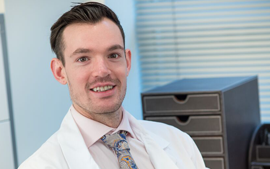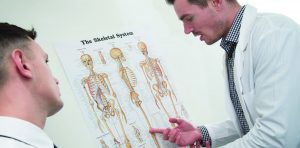Osteopath vs Chiropractor
What Is The Difference Between an Osteopath Chiropractor and Physiotherapist?
Have you ever wondered what the difference is between osteopaths, chiropractors and physiotherapists? You wouldn’t be alone. I get asked all the time.
In truth?
Not much.
 Well… when I say not much I mean that all three professions focus on improving movement throughout the body, relief from musculoskeletal pain and a include a blend of manual therapy, exercise rehabilitation, and general health guidance. And of course all three are successful in their own ways – that’s why they exist.
Well… when I say not much I mean that all three professions focus on improving movement throughout the body, relief from musculoskeletal pain and a include a blend of manual therapy, exercise rehabilitation, and general health guidance. And of course all three are successful in their own ways – that’s why they exist.
To a degree there’s an element of crossover. Cases where osteopaths are more ‘physio’ than some physiotherapists and some physiotherapists more holistic than some chiropractors but the best option for you will essentially boil down to practitioners on an individual level. It’s a people thing – a case of how you get on with your practitioner, their care, their concern, their commitment to their profession and their clients.
Qualifications
 They matter. And the first point of note is that osteopaths and chiropractors, as primary healthcare practitioners need a Master’s degree to become skilled at diagnosing and managing conditions. The main difference being that physiotherapists cover more exercise therapy and specialise in exercise prescription and local soft tissue treatment.
They matter. And the first point of note is that osteopaths and chiropractors, as primary healthcare practitioners need a Master’s degree to become skilled at diagnosing and managing conditions. The main difference being that physiotherapists cover more exercise therapy and specialise in exercise prescription and local soft tissue treatment.
That said, with continuous professional development (CPD) courses and practical clinical experience, osteopaths and chiropractors soon catch up when it comes to hands-on exercise therapy.
Physiotherapists on the other hand specialise in exercise prescription and local soft tissue treatment.
Health Models
Both osteopaths and chiropractors conform to the holistic health model, physiotherapists to the allopathic. Perhaps the simplest way to distinguish between each is to look at holistic v allopathic and then osteopathy v chiropractic.
Read on…
Holistic vs allopathic models of medicine
 Allopathic models of medicine are primarily concerned with suppressing symptoms. A smart, short term relief it can can sometimes go against the body’s natural healing patterns. Examples of this are surgery and chemical management to inhibit or enhance how the body performs. The allopathic model is always monitored by a healthcare professional trained to follow a rigid step by step guide. As with any approach there are pros and cons – the biggest advantage is that it is tried, tested and established on empirical evidence (although even that has its shortfalls). Ideally a quick-fire intervention it is also absolutely essential during emergencies and short term management of injuries though can cause damage when used long term. And there’s little arguing with the principle that taking addictive and toxic drugs to manage long term back pain is less beneficial that osteopathic manipulation and good self management.
Allopathic models of medicine are primarily concerned with suppressing symptoms. A smart, short term relief it can can sometimes go against the body’s natural healing patterns. Examples of this are surgery and chemical management to inhibit or enhance how the body performs. The allopathic model is always monitored by a healthcare professional trained to follow a rigid step by step guide. As with any approach there are pros and cons – the biggest advantage is that it is tried, tested and established on empirical evidence (although even that has its shortfalls). Ideally a quick-fire intervention it is also absolutely essential during emergencies and short term management of injuries though can cause damage when used long term. And there’s little arguing with the principle that taking addictive and toxic drugs to manage long term back pain is less beneficial that osteopathic manipulation and good self management.
It’s usually followed by a set programme of physiotherapy. Prescriptive physiotherapy that normally follows a standard model of treatment irrespective of personal patient preferences or natural predisposition.
Broader and more inclusive the holistic model also has its downsides.
The quality of care can vary hugely varied though the rigour of osteopath or chiropractor qualification tends to weed out the less able practitioners.
Another disadvantage is cost. For example a pack of strong opiate based painkillers is far cheaper than 6-8 treatments with an osteopath.
Money well spent I’d argue when you consider the respective long term benefits of painkillers vs treatment, the opioid epidemic in the States telling its own story.
More than that the osteopathic/chiropractic holistic approach is focused tightly on individuals. Able to constantly repair and adapt the natural healing properties of the body are remarkable if given a holistic environment. 100% natural the osteopathic/chiropractic holistic approach gives the body that opportunity.
And yes, though fast acting drugs as a short term intervention have an essential role to play, who wouldn’t appreciate a more natural longer term form of pain relief?
Osteopathy vs Chiropractic
A brief history lesson. The origins of osteopathy and chiropractic are very similar. Osteopathy was founded by A.T Still MD a physician hugely frustrated with the long term efficacy of mainstream medicine (many treatments involved using arsenic and opium which had dangerous side effects) and the vested interests of those selling it.
Chiropractic was founded in 1895 by Daniel David Palmer, who was a teacher and grocer turned magnetic healer.
Ever since, the two professions have coexisted similar in their respective approaches to holistic health. For example as primary healthcare practitioners and diagnosticians, osteopaths and chiropractors aren’t just trained in physical muscle and bones, they are also trained to identify pathology and serious health concerns (which is the allopathic side of the profession).
The main difference between the two? Fundamentally chiropractic focuses more on the spine whereas osteopathy is more of an all body treatment with as much emphasis on foot and wrist problems as on spinal issues.
There’s also an argument over the difference in time spent with the patient. For example it’s not uncommon to for chiropractic clinics to suggest a set number of treatments (and upfront payment) after analysing x-rays. While there’s nothing intrinsically wrong with this most osteopaths (especially particularly here at the Movement and Wellbeing clinic) won’t try and lock patients into a long term commitment, let alone expect them to pay in advance.
We always take a much slower, more consultative approach based on 3-treatment re-strategising, If we aren’t seeing good improvements (more than short term relief) after three sessions we’ll explore other options. Clearly this is ailment dependent as some injuries can take months to resolve but as a rule you can always expect a much gentler, more consultative approach to treatment with osteopathy.
In Conclusion
At the end of the day, it’s important to say that all three professions are established, respected and effective. The main thing to remember is that whatever path you choose follow it’s the nature, the experience and the professionalism of the person sharing that journey with you that will have the greatest bearing on your health and wellbeing.
For any other questions, please contact the clinic on:
0161 209 3980
info@movementandwellbeingclinic.co.uk
Ed Madeley M.Ost